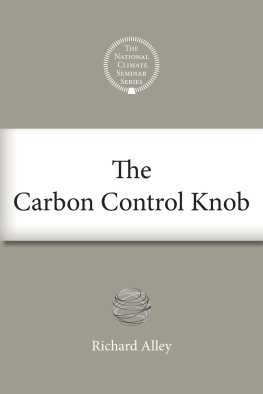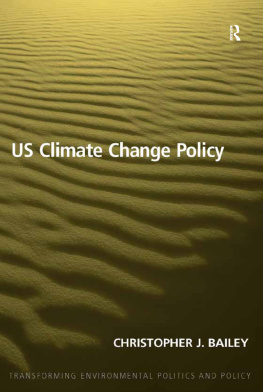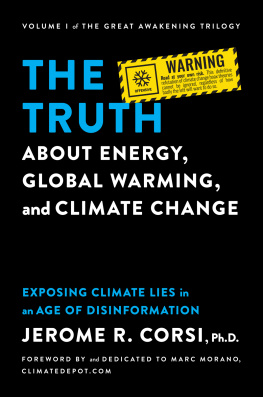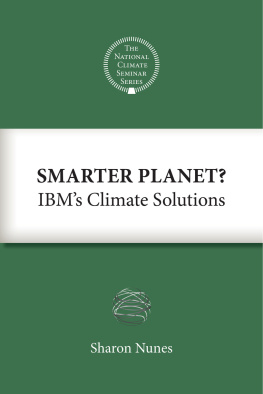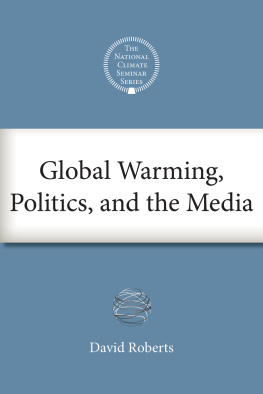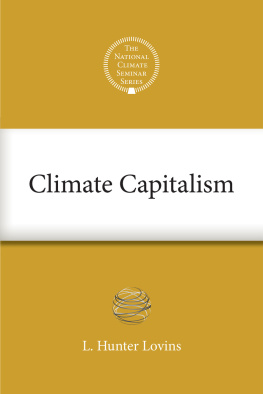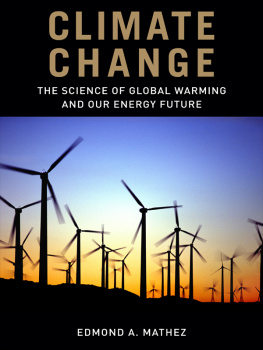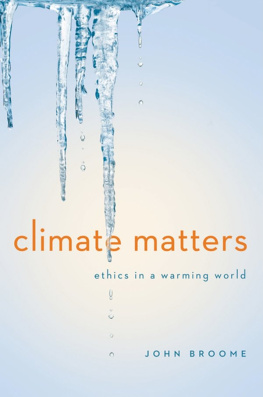The National Climate Seminar
The Carbon
Control Knob

Richard Alley

Washington | Covelo | London
Copyright 2012 Island Press
All rights reserved under International and Pan-American Copyright Conventions. No part of this book may be reproduced in any form or by any means without permission in writing from the publisher: Island Press, 2000 M Street, NW, Suite 650, Washington, DC 20036.
ISLAND PRESS is a trademark of the Center for Resource Economics.
Cover design by Maureen Gately
Cover image khalus, iStockphoto.com
Introduction
On November 2, 2011, Richard Alley participated in The National Climate Seminar, a series of webinars sponsored by Bard Colleges Center for Environmental Policy. The online seminars provide a forum for leading scientists, writers, and other experts to talk about critical issues regarding climate change. The series also opens a public conversation, inviting participants to ask questions and contribute their own thoughts.
Dr. Alley conducts research on the paleoclimatic record at Pennsylvania State University in order to understand the history, and perhaps the future, of climate change. In his lecture, Alley gave a concise overview of why we know what we know about climate change, and what that evidence can tell us about todays warming planet. Alley not only provides an accessible science lesson, but also reveals his own greatest concerns about climate change and offers advice to those who want to stop debating the subtleties of climate science and act now.
What follows is an edited version of Alleys talk and the subsequent question and answer session. While some material has been cut and some language modified for clarity, the intention was to retain the substance of the original discussion.
The Carbon
Control Knob
Seminar by Richard Alley
I have the great good fortune to work on the history of climate. A longer version of my discussion here is available for free online at here
When we read the history of climate, we get a very clear picture. It is indeed possible, with fairly high confidence, to figure out what climate was like in the past. We can recognize the deposits of glaciers spread across the landscape today and say, Look, theyre in places that are now warm. But there used to be ice there; it must have been colder.
In the same way, we can reconstruct the factors that might have changed climate. We have some indications of how bright the sun was. We certainly have indications of volcanoes that were throwing up ash to block the sun. We can study CO. For the last 800,000 years, we have had bubbles in ice cores. And we know that the recently trapped bubbles beautifully reproduce whats been measured in the atmosphere.
If we want to study periods earlier than those for which we have atmospheric measurements, we can go to Antarctica, to different places with different impurity loadings, different temperatures, different snowfall rates, and they have the same record. They are not being controlled by anything other than what was in the atmosphere. Our understanding of this is actually very good. Looking back through the oldest reconstructed ice cores, we can get a very good estimate of CO in the atmosphere.
Older than ice cores, its not quite as obvious, but we still can get decent CO estimates. If you change CO in the atmosphere, the chemistry of the ocean changes. Were now worried about ocean acidification, and the changes are recorded in some shells chemistry and isotopes. Changing CO in the atmosphere changes the minerals that are deposited in evaporating lakes like the Great Salt Lake.
When CO is more abundant, plants can be pickier about using the light isotope that reacts more easily. When CO is rare, they have to use whats available and they use more of the heavy isotope. When CO is common, plants can actually grow leaves with fewer stomata: there are fewer mouths to breathe through because they can get enough CO and they dont waste as much water.
If we look at the big picture, what do we learn? If the sun gets brighter, we warm up. If a volcano blocks the sun, we cool down. If you take a continent and move it from the equator to the pole, the continent gets colder, and if you move the continent from the pole to the equator, the continent gets warmer. If you move the continent to block an ocean current, it affects the climate where the current used to flow.
Many factors affect climate. There are also some factors that are very subtle and probably dont matter much. When the earths magnetic field changed strength, the climate didnt follow. We have records from 40,000 years ago that indicate that the magnetic field reached almost zero. That meant we were no longer as protected from cosmic rays. Those rays came streaming into the earths system, breaking atoms and creating radiocarbon and other things. But if theres a cosmic ray effect, it must be very subtle because the climate largely or completely ignored these large changes in cosmic rays. Some factors clearly matter and others dont.
The meteorite that killed the dinosaurs put up a lot of dust, but other than that, we dont see much evidence for changes in dust from space. Its not an important factor. What we do see is a very tight linkage between CO and temperature over long time periods. It doesnt matter if you look at the last century or the last 100,000 years or the last 100,000,000 years or the last billion years. You see a very tight link between CO and temperature.
Were going to explore that connection a little bit. The fact that CO warms is based on physics that weve understood for more than a century. The mere existence of a correlation between CO and temperature is not whats driving us to believe that CO causes warming. But it gives us a test of our physical understanding, and we pass with flying colors. When we apply that understanding of physics to paleoclimate, the effects of CO explain much of what happened. Nothing else similarly explains all those things. So were pretty confident about our conclusions.
We always run into this absolutely fascinating question: to what extent is CO rising because its warmer, and to what extent is it warmer because CO is rising? Which is the chicken, which is the egg, and how are they related?
We are reasonably confident that over time periods of centuries or millennia, warmer temperatures will raise CO, which makes it still warmer. The CO can be an amplifier. Over time periods of a million years or longer, warmer temperatures tend to reduce CO levels in the air. Its very funny; if its warmer in the short term, you get more CO in the air. But in the long term, you get less CO in the air.
It shouldnt be entirely surprising that there are processes that have different short-term and long-term effects. If I eat more, Im going to gain weight. Except if I ate three or four jalapeos, I might have to run to the bathroom and Id lose weight in the short term.
If temperature rises in the short term, that likely raises CO, and in the long term, it lowers CO. Lets walk through the processes that make this happen. A volcano spews CO and rocks. Then rain picks up CO from the air, making weakly acid rain. Acid rain breaks down the rocks, carrying the products to the ocean, where they get put into shells and subducted down into zones that feed volcanoes.
Over millions of years, volcanoes release rock and CO 2, which get recombined and then run down through the earth and back to feed the volcano again. How much acid rain is attacking the rocks is based on chemical reactions, which happen faster when its warmer. If you turn up the temperature, eventually the CO reacts with the rocks faster and that lowers CO. And if you wait a million years, any CO we put up in the air will eventually be taken down by nature. If youre thinking about a billion years of Earths history, we dont matter and our CO doesnt matter. So whats the big deal? If youre thinking about shorter time frames, then maybe we do matter.
Next page
